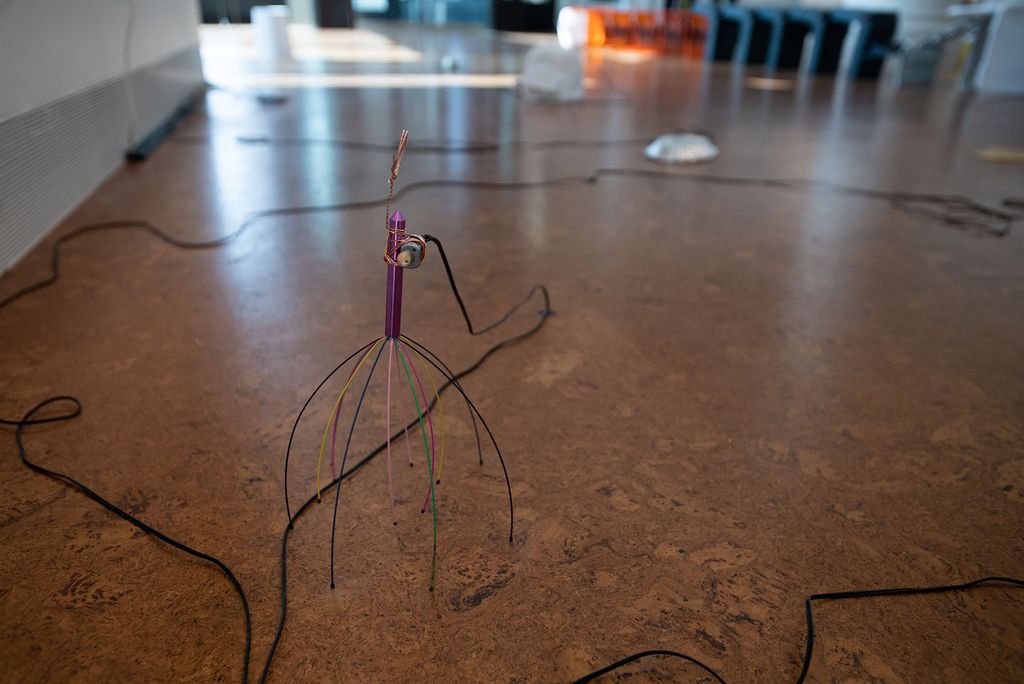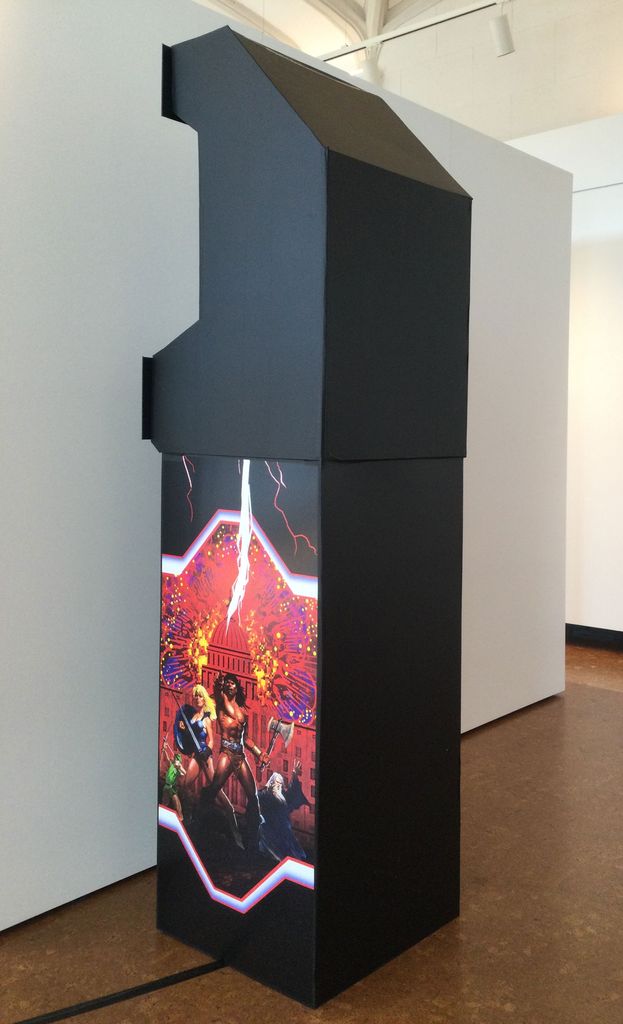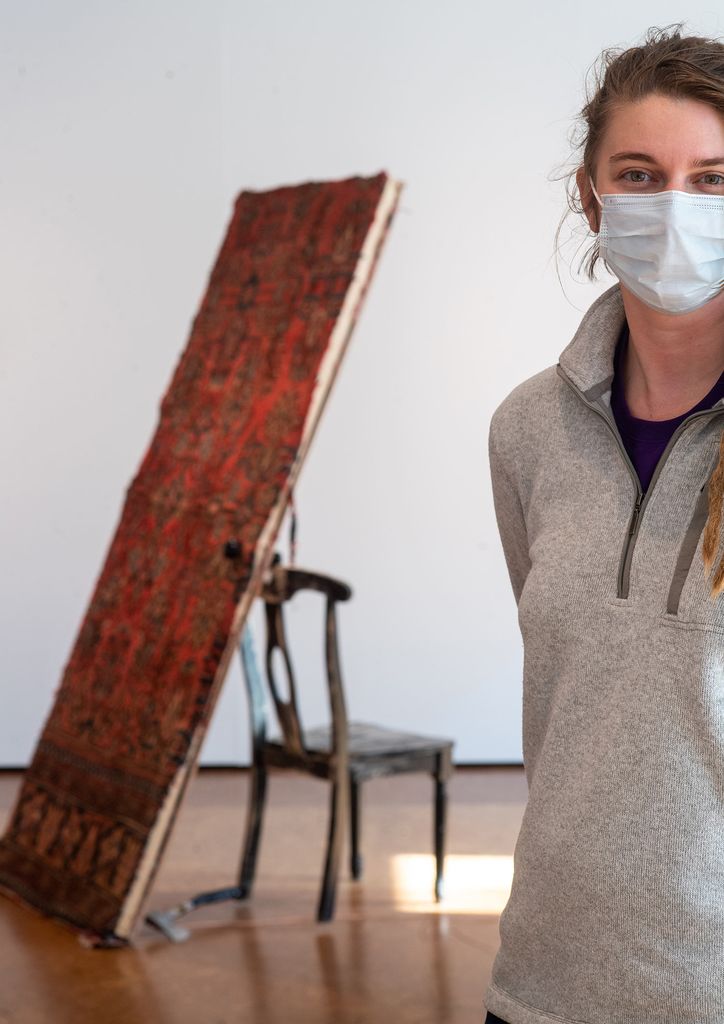Stone Gallery Hosts MFA Sculpture Thesis Exhibition

CFA’s David Snyder at the 2021 MFA Sculpture Thesis Exhibition, in front of an untitled piece by Aris Hu (CFA’21). The show runs through Friday, March 12 at the Faye G., Jo,. and James Stone Gallery. Photo by Cydney Scott
Stone Gallery Hosts MFA Sculpture Thesis Exhibition
2020 and 2021 CFA graduates’ work on display through March 12
Entering the Faye G., Jo, and James Stone Gallery, you’re greeted by a cacophony of sounds—whirls, clicks, and rattles—that echo off the walls and high ceilings of the College of Fine Arts gallery. It’s all part of the multisensory experience of this year’s MFA Sculpture Thesis Exhibition. The nine pieces on display by five talented artists pull viewers around the spacious room.
This year’s exhibition, on view through Friday, March 12, is a little different from years past—it features the work of both 2020 and 2021 MFA graduate students. Three of the featured artists weren’t able to show their work last year because of the pandemic, and they have been included with current MFA candidates. The 2020 graduates created new work for the show, moved by the pandemic and other events of the intervening year.
Chang Wu (CFA’20) says when he came to BU he was immersed in a culture different from what he knew. He became interested in the barriers between languages and how words can mean different things to different people.
“Through the translation of languages, maybe there’s a space to explore where they come together,” he says. Reflecting on communication, Wu started playing with the idea of turning audio into movement in his art.
Wu’s piece The Stuff–As–Dreams Are Made–On uses found and constructed objects with electrical components to create an experience that challenges viewers to think about how those objects can be transformed. He recorded the sound of objects—among them a Chipotle takeout container, a plastic straw, and a styrofoam box—being moved. Videos of the objects making noise appear on a screen nearby.

Using engineering, Wu turned the found objects into audio exciters (technology that can turn an everyday object into a speaker by using electrical impulses). The recorded sounds are played back in the form of electricity that, through wires, makes the object move to re-create the original sound.
The artist says he was interested in manipulating noise, turning a sound wave into an electrical impulse, then into movement, and finally, back into sound.
“My work is not an answer,” he says, “it is a suggestion and question to think about what we can do with our objects.”
Walking through the gallery, the artists’ influence on one another is apparent. Aris Hu (CFA’21) learned some of the technical skill needed to create her huge, constantly moving sculpture made of PVC pipe, wire, and construction objects through conversations with Wu, says David Snyder, a CFA assistant professor and chair of graduate studies in sculpture. He describes Hu’s piece as an “unruly, miniature construction scenario” whose constant motion makes it feel “like improvisatory music.”
He says one of the pervading themes across all the work of the artists in this year’s show is moving away from the computer screens that have held us all captive during the pandemic, and in those instances where the art appears on a screen, thinking about how that changes our perception of the work. “An important aspect of the show is that we live in a world where there is a reduction of information to a single plane,” Snyder says. “One of the arguments all the artists are dealing with is scratching that surface.”
Jennifer Kilburn (CFA’20) is one of the artists scratching that surface. She shipped work for the show from Tampa, Fla., where she now lives, then arranged the piece for the exhibition.

Kilburn received a BU Graduate Arts Research Grant in 2019 to travel to Ukraine and visit the Chernobyl area, site of the 1986 nuclear disaster, to create her 2020 thesis work centered on the apocalypse.
“But then the actual apocalypse happened,” she says, referring to the events of January 6, 2021, in Washington, D.C.
Her work quickly shifted to address the storming of the US Capitol. Her sculpture Insurrection looks like an ’80s arcade game. The vinyl sides depict caricatures of rioters in video game–style art, and the sculpture plays a loop of whoops and dings as the word “Insurrection” flashes.
Snyder says the piece is designed to highlight some of the “anachronistic cultural ideas” that were behind the riots.
Ania Garcia Llorente (CFA’20) pushes boundaries with her untitled sculpture made from what she calls local trash.
Returning to Boston for this year’s exhibition, Garcia Llorente was struck by the prevalence of trash around the city—the constant cycling of college students’ furniture in Allston, the curbside strollers and window fans that litter streets. She collected found objects from all over to create an intentionally disruptive piece in the middle of the Stone Gallery.
Visitors often use a gallery space as a hallway, moving through without taking in the art around them, she says. Her sculpture runs the width of the gallery, essentially splitting the space in two and forcing visitors to move around the work.

The piece includes some recognizable objects, like window fans, and others whose original form is hardly discernible, like PVC pipe, strollers, and other found objects, subtly manipulated so they’re attached. Garcia Llorente, who spent part of the past year as an artist-in-residence in Oklahoma, says that one of the most valuable aspects of BU’s MFA program was the conversations she had with fellow students.
It’s an opinion echoed by Hannah Minifie (CFA’21), who has three works in the show. She recalls a class where each student was challenged to bring in a single object and talk about it for hours.
The program “changes the way you think about art,” she says. “You take time to think about the object, think about how you’re thinking about it, think about how other people are thinking about it, and then you’re like—wait, we can talk about a mug for three hours?”

Minifie says the program has allowed her to grow as an artist. Her work in the show is technically impressive and cerebral, three pieces that explore space, thresholds, and communication.
Minifie says she had been thinking about what doors represent—exclusion, inclusion, privacy, and the separation of spaces—as she began work on her sculpture Three Doors. The first component, a wooden door with “The Office of Strategic Communication” painted on it, is freestanding, allowing, she says, for any space around it to become a designated office space.
She was fascinated, she says, with the idea of what the “essence” and “sound” of a door is. “Is it the sound of knocking?” she asks, rapping on one of the gallery walls. “No, because a wall can make that sound too. The unique sound of a door is the sound of it breaking.”
The sculpture’s second door, laying on the floor with a video projected on it, has been destroyed. Minifie used a hatchet to break the door down, recorded the demolition sound, and piped the noise into the third door, turning it into an audio exciter, using the same technology as Wu used.
She also wanted to put the sound of a door into something that wasn’t actually a door, so she created a look-a-like door using carpet and wood. Supported by a chair and the hatchet, the carpet plays the noise of the artist’s demolition.
“The carpet door is tied together with the instrument of destruction,” she says. “Even though the sound implies destruction, it is actually really secure. The chair is supposed to conjure the idea of lodging furniture under a door handle to prevent anyone from entering, creating an image of violence.”
Minifie has two other pieces in the exhibition, one that also reflects on her questions about doors and thresholds, and a completely different piece in the opposite corner of the gallery, Voice Box, where she interviewed people about transformational experiences, then deleted the words so the recording was of the space between them, using exciters for this piece as well.
“Art is not about answers, it’s not about telling a story with a beginning, middle, and end. It is about creating an experience for the viewer where they can draw on their own experiences and see something,” she says. “Sculpture now is so much more expansive than most people know. It is sound, it is video. It is space and time.”
The MFA Sculpture Thesis Exhibition is at the Faye G., Jo, and James Stone Gallery, 855 Commonwealth Ave., through Friday, March 12; hours: Monday to Friday, 11 am to 5 pm. Because of the pandemic, exhibition visitors are limited to on-campus BU students, faculty, and staff. A virtual tour will be available soon for other visitors.
Comments & Discussion
Boston University moderates comments to facilitate an informed, substantive, civil conversation. Abusive, profane, self-promotional, misleading, incoherent or off-topic comments will be rejected. Moderators are staffed during regular business hours (EST) and can only accept comments written in English. Statistics or facts must include a citation or a link to the citation.